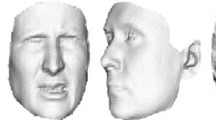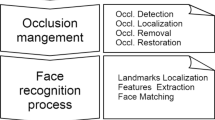Abstract
This paper presents an innovative approach for the detection of faces in three dimensional scenes. The method is tolerant against partial occlusions produced by the presence of any kind of object. The detection algorithm uses invariant properties of the surfaces to segment salient facial features, namely the eyes and the nose. At least two facial features must be clearly visible in order to perform face detection. Candidate faces are then registered using an ICP (Iterative Correspondent Point) based approach aimed to avoid those samples which belong to the occluding objects. The final face versus non-face discrimination is computed by a Gappy PCA (GPCA) classifier which is able to classify candidate faces using only those regions of the surface which are considered to be non-occluded. The algorithm has been tested using the UND database obtaining 100% of correct detection and only one false alarm. The database has been then processed with an artificial occlusions generator producing realistic acquisitions that emulate unconstrained scenarios. A rate of 89.8% of correct detections shows that 3D data is particularly suited for handling occluding objects. The results have been also verified on a small test set containing real world occlusions obtaining 90.4% of correctly detected faces. The proposed approach can be used to improve the robustness of all those systems requiring a face detection stage in non-controlled scenarios.
Similar content being viewed by others
References
Belhumeur, P.N., Hespanha, J.P., Kriegman, D.J.: Eigenfaces vs. fisherfaces: Recognition using class specific linear projection. IEEE Trans. Pattern Anal. Mach. Intell. 19, 711–720 (1997)
Qing, L., Shan, S., Chen, X.: Face relighting for face recognition under generic illumination. In: IEEE International Conference on Acoustics, Speech, and Signal Processing. Proceedings (ICASSP), vol. 5, pp. V-733-6 (2004)
Bronstein, A.M., Bronstein, M.M., Kimmel, R.: Expression-invariant 3D face recognition. In: Proc. Audio and Video-Based Person Authentication. LCNS, vol. 2688, pp. 62–70. Springer, Berlin (2003)
Lu, X., Jain, A.K.: Deformation analysis for 3d face matching. In: Application of Computer Vision. WACV/MOTIONS, vol. 1, pp. 99–104 (2005)
Y.-Y., Lin, T.-L., Liu, C.-S., Fuh: Fast object detection with occlusions. In: The 8th European Conference on Computer Vision (ECCV), Prague, May 2004
Hotta, K.: A robust face detector under partial occlusion. In: Proceedings of ICIP, pp. 597–600 (2004)
Park, J.S., Oh, Y.H., Ahn, S.C., Lee, S.W.: Glasses removal from facial image using recursive error compensation. IEEE Trans. Pattern Anal. Mach. Intell. 27(5), 805–811 (2005)
Martinez, A.M.: Recognition of partially occluded and/or imprecisely localized faces using a probabilistic approach. In: Proc. IEEE Conf. Computer Vision and Pattern Recognition, vol. 1, pp. 712–717 (2000)
Martinez, A.M.: Recognizing imprecisely localized, partially occluded and expression variant faces from a single sample per class. IEEE Trans. Pattern Anal. Mach. Intell. 24(6), 748–763 (2002)
Kim, J., Choi, J., Yi, J., Turk, M.: Effective representation using ICA for face recognition robust to local distortion and partial occlusion. IEEE Trans. Pattern Anal. Mach. Intell. 27(12), 1977–1981 (2005)
Tarrés, F., Rama, A.: A novel method for face recognition under partial occlusion or facial expression variations. In: Proc. 47th Int’l Symp. ELMAR, pp. 163–166 (2005)
Colombo, A., Cusano, C., Schettini, R.: 3D face detection using curvature analysis. Pattern Recogn. 39(3), 444–455 (2006)
Everson, R., Sirovich, L.: Karhunen-Loève procedure for gappy data. J. Optical Soc. Am. A 12(8), 657–1664 (1995)
Colombo, A., Cusano, C., Schettini, R.: A 3D face recognition system using curvature-based detection and holistic multimodal classification. In: Proc. 4th Int’l Symp. on Image and Signal Processing and Analysis, pp. 179–184 (2005)
Lu, X., Jain, A.K., Colbry, D.: Matching 2.5D face scans to 3D models. IEEE Trans. Pattern Anal. Mach. Intell. 28(1), 31–43 (2006)
Besl, P.J., McKay, N.D.: A method for registration of 3-D shapes. IEEE Trans. Pattern Anal. Mach. Intell. 14, 239–256 (1992)
Chang, K., Bowyer, K.W., Flynn, P.J.: Face recognition using 2D and 3D facial data. In: ACM Workshop on Multimodal User Application, pp. 25–32 (2003)
Pulli, K.: Multiview registration for large data sets. In: Proc. 3DIM (1999)
Rusinkiewicz, S., Levoy, M.: Efficient variants of the ICP algorithm. In: Third International Conference on 3D Digital Imaging and Modeling (3DIM) (2001)
De Smet, M., Fransens, R., Van Gool, L.: A generalized EM approach for 3D model based face recognition under occlusions, In: 2006 IEEE Computer Society Conference on Computer Vision and Pattern Recognition, vol. 2, pp. 1423–1430 (2006)
Watt, A.H.: 3D Computer Graphics. Addison Wesley, Reading (1999)
Horn, B.K.P.: Closed-form solution of absolute orientation using quaternions. J. Opt. Soc. Am. A 4(4), 629–642 (1987)
Wang, Y., Chua, C.-S.: Face recognition from 2D and 3D images using 3D Gabor filters. Image Vis. Comput. 23(11), 1018–1028 (2005)
Faltemier, T.C., Bowyer, K.W., Flynn, P.J.: Using multi-instance enrollment representation to improve 3D face recognition. In: Int. Conference on Biometrics, Theory, Applications, and Systems, BTAS, pp. 1–6 (2007)
Gross, R., Matthews, I., Baker, S.: Active appearance models with occlusion. Image Vis. Comput. 24(6), 593–604 (2006)
Huang, P.S., Zhang, S.: Fast three-step phase shifting algorithm. Appl. Opt. 45, 5086–5091 (2006)
Yin, L., Wei, X., Sun, Y., Wang, J., Rosato, M.J.: A 3D facial expression database for facial behavior research. In: FGR’06: Proceedings of the 7th International Conference on Automatic Face and Gesture Recognition, pp. 211–216 (2006)
Alyuz, N., Gokberk, B., Akarun, L.: A 3D face recognition system for expression and occlusion invariance. In: 2nd IEEE International Conference on Biometrics: Theory, Applications and Systems (BTAS 2008), pp. 1–7 (2008)
Author information
Authors and Affiliations
Corresponding author
Rights and permissions
About this article
Cite this article
Colombo, A., Cusano, C. & Schettini, R. Gappy PCA Classification for Occlusion Tolerant 3D Face Detection. J Math Imaging Vis 35, 193–207 (2009). https://doi.org/10.1007/s10851-009-0165-y
Received:
Accepted:
Published:
Issue Date:
DOI: https://doi.org/10.1007/s10851-009-0165-y




